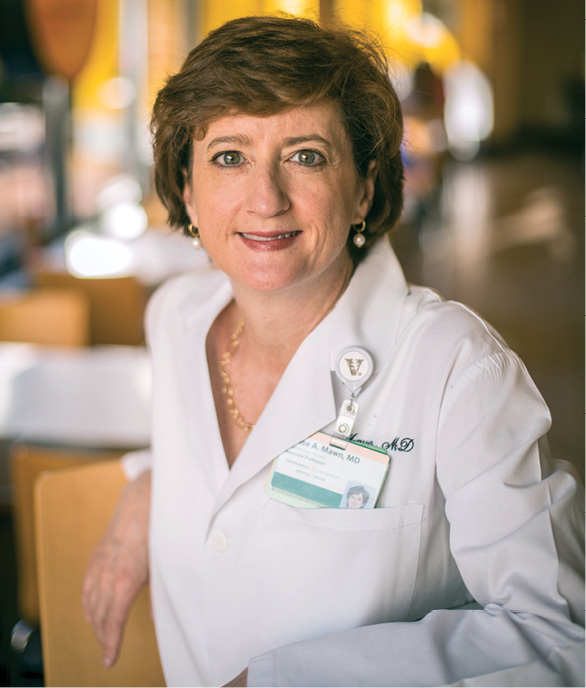
By Nancy Humphrey
Noelle Kerlin is wary of food like some 2-and-a-half-year-olds are fearful of strangers or growling dogs: Every bite has the potential for harm. She’s learned at a very young age that food can be her enemy.
The tiny blonde with a headful of curls is allergic to more than 30 foods—all milk options (cow, soy, almond), wheat, rice, oats, corn, chicken, bananas, pineapple, watermelon, peaches, cheese, eggs and more. Potatoes are the only carbohydrate she can eat.
“She cried most of the first 18 months of life,” says Kristi Kerlin, Noelle’s mother. “Now she can tell us her belly hurts. At some point she knew ‘food doesn’t make me feel good,’ so now she doesn’t have much interest in food. We lock up our medicine cabinets and our cleaning supplies. With kids with food allergies, you feel like you need to lock up your food, too.”
Noelle’s reactions to allergens are varied. She’s broken out in quarter-size hives, and foods have made her throat itch and her eyes red-rimmed. She vomits, has diarrhea and, because of the diarrhea, has severe diaper rashes.
Because her diet is so limited, she drinks 24 ounces a day of an elemental formula for children with milk allergies that supplies all her nutrients.
As a result of her allergies, she has been diagnosed with eosinophilic esophagitis, a condition caused when a type of white blood cell builds up in the esophagus as a reaction to foods, allergens or acid reflux. It will require lifelong management.
Luckily, her reactions have not included anaphylaxis, a severe, potentially life-threatening allergic reaction that can occur within seconds or minutes of exposure to allergens. Anaphylaxis results in lowered blood pressure and dilated blood vessels. In severe cases a person can go into shock and it can be fatal. Many people who have severe allergies keep an autoinjector (EpiPen) on hand to deliver a measured dose of epinephrine (also known as adrenaline) in case of anaphylaxis.
“Noelle goes everywhere with an EpiPen and Benadryl,” Kristi says. “Some people think that having a food allergy isn’t a big deal and that moms [of children with food allergies] are high-strung. Yes, we are. Our kids’ lives are at stake. We try not to let it rule our lives, but it’s hard. You can forget spontaneity. She can’t even play with Play-Doh because it has wheat in it.”
The Kerlins, who have two other children without food allergies, have learned where they can go to eat out. Chick-fil-A french fries, for example, are cooked separately from chicken, so they’re safe. And some local chefs will prepare food safely for Noelle.
“Anybody who keeps her has to know how to use the EpiPen. There’s a small group of people we trust,” Kristi says. “We have an action plan filed at her preschool. If she breaks out in a rash or vomits, she gets Benadryl and then they call us. If she has breathing difficulty, she gets a shot with the EpiPen, and they will call Vanderbilt and then us.”
THE SUPER 8
A food allergy is an abnormal response to a food, triggered by the body’s immune system. The immune system responds to the food as if it were a threat.
Called the “Super 8,” the most common allergenic foods are milk, eggs, peanuts, tree nuts (such as almonds and walnuts), fish, shellfish, soy and wheat. They account for an estimated 90 percent of food allergic reactions.
According to Food Allergy Research and Education (FARE), about 1.5 million Americans have food allergies. They affect one in every 13 children under age 18 in the U.S.—or about two in every classroom. Experts differ on whether or not strong evidence exists that food allergies are increasing.
The Centers for Disease Control and Prevention says that the number of children with food allergies rose 18 percent between 1997 and 2007. Dr. Marshall Plaut, chief of food allergy, atopic dermability and allergic mechanisms with the National Institute of Allergy and Infectious Diseases (NIAID) of the National Institutes of Health, says the evidence of increase “may be correct, but it is relatively anecdotal.”

“We just don’t know. We believe the problem is increasing, but we just aren’t sure,” he says. Many believe that hygiene, or extreme cleanliness, might be partly to blame for allergies in industrialized nations, Plaut adds.
The “hygiene hypothesis” states that excessive cleanliness in our antibacterial society interrupts the normal development of the immune system, and that this change leads to an increase in allergies. In other words, a very clean lifestyle has eliminated many of the types and quantity of germs the immune system actually needs to develop into a less allergic system.
Another theory states that other environmental factors, like pollution and added chemicals in our diet, are involved.
“It’s a very interesting theory,” says Dr. Stacy Dorris, MD’07, assistant professor of pediatrics and a pediatric allergist at Vanderbilt University Medical Center. “We’re too clean in one direction—we don’t get the big, serious childhood diseases we used to get—and on the flipside, we have more environmental insults—air pollutants and chemicals in our diet—that are probably skewing our immune system toward an allergic profile. Probably it’s a combination of the two.”
But Dorris says it’s important to keep food-allergy occurrence rates in perspective. According to a FARE-funded study, only about 1 percent of all young children in the U.S. have a peanut allergy, one of the most common and life-threatening food allergies.
“It’s still a very unusual disease,” she says. “You hear a lot about it in the media, about peanut-free schools and that sort of thing, but it’s still a very unusual condition. And many food allergies can be outgrown.”
According to FARE:
• Peanut and tree-nut allergies, which tend to develop in childhood, are usually lifelong.
• Cow’s milk, egg and soy allergies typically begin in childhood and eventually may be outgrown. However, in the past, most children outgrew these allergies by school age. A recent study conducted by researchers at Johns Hopkins University School of Medicine indicated that children are taking longer to outgrow milk and egg allergies. Fortunately, the majority are allergy-free by age 16.
• Fish and shellfish allergies also tend to be lifelong. More than 6.5 million adults are allergic to finned fish and shellfish.
• Children with multiple food allergies outgrow their allergies less frequently, and these children often have associated severe eczema, asthma and rhinitis.
Food allergies can develop out of the blue at any time in life because the immune system is “incredibly dynamic and constantly in motion,” Dorris says. The severity also varies. One child may break out in hives while another experiences life-threatening anaphylaxis.
Dorris also has personal experience with food allergies: Her 4-year-old daughter, Andie, has been allergic to peanuts since she was 1. About a year ago Andie went to work with her father on a snow day and took a bite from a protein bar containing peanuts that she’d found in her father’s assistant’s drawer.
“Even a couple of hours after Benadryl, her lips were swollen, she had hives on her face, and her ears were swollen twice their normal size,” Dorris recalls. “Later she had diarrhea. This was after one bite.”
‘HE SOUNDED LIKE A CRYING SEAL’
Nine-year-old Christopher Clauss of Columbia, Tennessee, was diagnosedwith an allergy to peanuts, tree nuts and eggs when he was about 1. “But we avoid all nuts,” says Eric Clauss, Christopher’s father, a paramedic and nurse who, along with Christopher’s older sister, has food allergies. “It’s what you don’t know that’s scary, and sometimes you just don’t know,” he says, adding that the family looks at all foods as potential allergens.

When he was 4, Christopher ate some cheese, which he had safely eaten before. He quickly developed an all-over body rash. “Our routine had been to give him Benadryl, but his reaction continued,” Eric remembers.
Within moments Christopher’s breathing became labored. He was experiencing anaphylaxis and was nearly unconscious. “It was that fast. Although I am prepared for something like that as a nurse, you’re not when it’s your son.”
Eric stuck Christopher with an EpiPen, and his condition rapidly improved within a minute or so. Then he drove him to Vanderbilt, about an hour away. In hindsight, that wasn’t a good idea, Eric says. The dose of epinephrine may wear off fairly quickly, and severely allergic patients sometimes may need a second dose. Luckily, Christopher did not.
Eric says Christopher’s anaphylactic episode was “terrifying.”
“He sounded like he was trying to breathe through a straw. He was starving for air, and you could see his chest muscles working so hard. He made a high-pitched screeching sound. He sounded like a crying seal.”
At the Pediatric Emergency Department at Monroe Carell Jr. Children’s Hospital at Vanderbilt, Christopher was given steroids by IV and monitored for six hours. Two years later he was back with another severe reaction.
Eric has instructed Christopher’s teachers about how to administer the EpiPen. Last year the Tennessee Legislature passed a bill requiring public and private schools to have at least two EpiPens on hand to treat students in the event of a severe allergic reaction.
“The most challenging thing for us is when he’s with others,” Eric says. “We don’t know what happened with the cheese incident, and that’s scary. There could have been something on the slicer where it was sliced, or it could have been a preservative. To this day we don’t know.”
Christopher follows a ritual when he eats a new food. He takes a tiny bite of food and waits about five minutes to see if he has a reaction. Usually his mouth “feels funny” or his stomach hurts if he’s allergic. If he starts to react, he doesn’t eat any more, and he brushes his teeth to get rid of food particles.
Eric says dealing with food allergies is simply a part of life for Christopher and his family. “We’ve told him there are certain things you have to deal with in life, and this is one of them. It could be a lot worse.”
Dr. Jane Choi, MD’98, a Vanderbilt adult allergist and assistant professor of medicine, says the number of patients with food allergies in her practice has increased. And they are seeing new types of allergies, including a red-meat allergy brought on by a tick bite, as well as exercise-induced food allergies.

Choi recommends that her allergy patients carry two EpiPens with them at all times in case a severe reaction requires an additional dose, or if the first one misfires. Patients with suspected food allergies are asked to keep a food diary and event log to help the allergist narrow down what might be causing an allergic reaction.
“In addition to being a physician, you also have to be a detective,” says Choi, who had an anaphylactic reaction to cashews when she was an allergy fellow at Johns Hopkins. Although she had eaten cashews before, she ate more than usual between seeing patients. She collapsed while examining a patient.
“Sometimes you have very astute patients who have diagnosed themselves by the process of evaluation,” she says, “but other times it would be helpful to be a fly on the wall to see what’s going on in their lives.”
‘AT THE AGE OF 48, I HAVE A FOOD ALLERGY?’
Dr. Louise Mawn—a busy Vanderbilt eye surgeon, associate professor, and mother of four children, ages 8 to 14—credits her Vanderbilt primary care physician, Dr. Jan Price, with sifting through Mawn’s debilitating symptoms and suspecting a food allergy.
In 2012, Mawn was convinced she had a serious illness because of the severity of her symptoms. “I had a whole cornucopia of symptoms,” she recalls, including a lump in her throat, extreme fatigue, swelling of her face and eyelids, and stomach upset.
The lump in her throat ended up being the base of her swollen tongue. It was all she could do to show up early in the morning for work and stay awake until early evening when her family was fed.
Price sent her to a rheumatologist and a gastroenterologist to rule out other illnesses, with visits to the Vanderbilt Asthma, Sinus and Allergy Program (ASAP) sprinkled in between. With the help of Adam Cates, a nurse practitioner at ASAP, her allergens were narrowed down and she was finally diagnosed with an allergy to food preservatives, like sulfites and nitrites.
The diagnosis came after a frightening trip to an out-of-town medical conference where she was convinced she was going to lose her airway.
The allergist sent her home with a weeklong elimination diet of black tea, white rice and grilled chicken. After eliminating the preservatives from her diet, her symptoms disappeared. “I never went back to the allergist to have it honed down [about specific preservatives] because as soon as I stopped eating preserved foods, I was better. All my symptoms went away like magic.”

Mawn is grateful for Price’s careful “Nancy Drew-like meticulous investigation” into her symptoms. “When she suggested I might have a food allergy, I laughed. I felt like I was humoring her by going to the allergy appointment. I said, ‘At the age of 48, I have a food allergy? Are you kidding me?’ But Dr. Price, with the help of ASAP, put it all together.”
WHAT’S AHEAD?
NIAID’s Plaut says one of the most promising NIH-funded research projects focuses on whether the timing of when foods are introduced to infants makes a difference in the development of an allergy. “The popular theory has been that you avoid an allergy by avoiding the food, when, in fact, that may be the exact opposite of what we should do,” he says.
The NIH-funded LEAP study (Learning Early About Peanut allergy) took place in London, where the standard of care, like that in the United States, has been to avoid peanuts in early childhood.
Recently, the standard of care in the U.S. has changed, so there is no recommendation for either avoiding or eating peanuts because it’s unclear that avoiding them is helpful. The LEAP clinical research study aims to determine the best strategy for preventing peanut allergy in young children, as the majority of children have their first reaction to peanuts between 14 and 24 months of age. Children who are allergic to eggs or suffering from eczema are at highest risk.
The LEAP study looked at 640 children who were enrolled in the study when they were between 4 months and 10 months of age. The children were randomized into two groups: one that avoided peanut-containing foods until age 5, and another that received an age-appropriate peanut snack at least three times a week beginning when they entered the study. The study, which ended in May 2014, monitored children until age 5 to see which method—avoidance or consumption—works best for preventing peanut allergy. The results soon will be available.
Other research is aimed at treatment, because no effective therapy for food allergies exists beyond food-allergen avoidance and rapid medical treatment for allergic reactions to accidental exposures.
One NIH-funded research study is looking at oral immunotherapy (OIT), in which patients with food allergies are fed small, incremental amounts of a food to which they are allergic. During the course of several months, the patients build up to a maintenance dose and then continue therapy at home. The goal is to desensitize the patient so that the food no longer causes an allergic reaction.
Three types of allergen-specific immunotherapy are currently being investigated in NIH-funded studies in the United States: oral, sublingual (under tongue) and epicutaneous (patch). These therapies are in various stages of clinical investigation.
“Because these studies got underway only a few years ago, we don’t yet have a lot of data about the effectiveness of these methods,” Plaut says. “We have more promising data on oral therapy than the other two. But we just don’t know about long-term benefits.”
For Louise Mawn, an allergy diagnosis resulted in a huge lifestyle change, particularly because the family’s normal diet consisted of many processed and fast foods that she could get on the table quickly. “The microwave was the most critical appliance in my kitchen,” she remembers.
Now her husband and children help prepare healthy, preservative-free meals. “We prefer to eat at home. It’s easier and it’s safer.”
Mawn doesn’t bemoan her diagnosis. “It seems to me I got off scot-free,” she says. “I thought I had a serious disease. I thought I was going to be leaving those four small children. I feel like I’m the luckiest person alive to have had all those symptoms simply because I can’t eat food that nobody’s supposed to eat anyway.
“I can’t have a Coke? OK. What’s in a Coke that any of us should have? Human beings are not supposed to eat chemically named foods. They’re supposed to eat carrots and squash and lettuce and apples.”
Nancy Humphrey is assistant director of Vanderbilt University Medical Center News and Communications. As the award-winning director of publications for VUMC, she supervises the editors of five Medical Center periodicals and serves as the department’s chief copy editor. With a master’s degree in journalism and history, she was once a general assignment and medical reporter for the Nashville Banner newspaper.